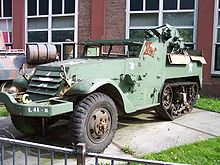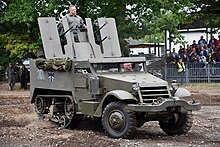M16 (half-track vehicle)
The M16 (original designation: M16 Multiple Gun Motor Carriage , M16 MGMC ) was an anti-aircraft tank made in the USA . The lightly armored half-track vehicle was developed in World War II on the basis of the M3 half-track vehicle . The M16A1 variant was the only half-track vehicle used by the German Bundeswehr .
history
The basic model was built in 1932 as the Halftrack T1 by the Cunningham company in Rochester, New York, and offered for sale to the US Army . Only in the course of the re-equipment / modernization of the US Army in 1939/40 was the vehicle accepted as the T14 and further developed into the armored transport car M2 (short version, equipment carrier) and M3 (armored personnel carrier).
The M3 manufacturers were White , Autocar and Diamond T , who built a total of 15,361 vehicles of all types. Since the demand of the allies was far greater than the three manufacturers' ability to manufacture for export, the International Harvester company was commissioned to produce a simplified version of the M3 for lend-lease auxiliary deliveries. These vehicles, which were delivered to the Canadian, British and Free French troops and the Red Army, were given the designation M5.
In April, work began on an anti-aircraft tank equipped with a 12.7 mm machine gun so that the motorized units could have a movable anti-aircraft component. The first model based on the M3 was called the M13 (M14 based on the M5) and was armed with two 12.7 mm machine guns. In November 1942, the M45 mount with four machine guns was developed to increase the firepower. The new vehicle was named M16 (M17 based on the M5).
Manufacturing numbers:
- M16 MGMC 1943: 2,323, 1944: 554, total 2,877 vehicles
- M17 MGMC 1943: 400, 1944: 600, total 1,000 vehicles
At the end of 1944 the construction of the halftracks was stopped, in 1947 all vehicles except for the M16 MGMC were declared “out of date” and almost all of them were given to other countries. Around 2,000 vehicles were stored. With the outbreak of the Korean War , the need for flak tanks exceeded the existing M16. The flak tanks were used less often for air defense, more often for use against ground targets.
In order to meet the demand, 1,662 vehicles of the basic variant M3 were converted into flak tanks by attaching the M45 mount. In the M16 MGMC, the uppermost side panels of the fighting compartment could be folded down so that the weapon system could be pivoted unhindered. In order to meet this requirement with the M3, a spacer ring was placed under the M45D mount, increasing the mount by around 35 cm. This vehicle was given the designation M16A1 MGMC to distinguish it. The mount was also given a protective shield for ground combat.
After the Korean War, the M16 / M16A1 were replaced by the M42 Duster full-track anti-aircraft tank , and the half-track vehicles that were released went to the German Bundeswehr, France, Belgium, the Netherlands, Norway and Israel.
Use in the Bundeswehr
The M16A1 was used in the initial phase of the Bundeswehr from 1956 to 1962 with 192 vehicles in the anti-aircraft battalions of the divisions . The main armament was still a 12.7 mm Flakvierling M51 , which was already obsolete when it was introduced to the Bundeswehr because the weapon system was ineffective against fast-flying jet fighters and the reference time was too slow.
As a half-track vehicle unique in the Bundeswehr, the M16A1 was not able to fully convince compared to the earlier types of the Wehrmacht from the war time. Technically, it was no less reliable and, at a nominal 72 km / h, significantly faster, but the user-friendliness ( no synchromesh gearbox and no laterally differentiated traction of the chains due to the lack of a superimposed steering gear ) and the off-road mobility were unsatisfactory despite the additionally driven front axle .
For these reasons, the M16A1 was decommissioned from the Bundeswehr in 1962 and replaced by the more modern and better protected flak tank M42 Duster . Some other states, such as Israel , continued to use this type in some cases until the end of the 1990s or at least kept it in reserve.
Technical specifications
- Length: 6.41 m
- Width: 1.96 m
- Height: 2.50 m
- Weight: approx. 9.8 t
- Engine: a series - six-cylinder - petrol engine White 160AX
- Displacement: 6,330 cm³ (386 in³)
- Compression: 6.3: 1
- Output: 147 PS (110 kW) - also throttled to 130 PS (95.60 kW)
- Gearbox: unsynchronized manual 4-speed gearbox with reverse gear and simple reduction
- Top speed: 72 km / h (nominal)
- Driving range: approx. 280 km (road)
- Crew: 5 men
Armament
- Version M16 and M17: A 12.7 mm Flakvierling , consisting of the mount M45D and four mounted machine guns M2HB caliber 12.7 mm (cal .50).
- Version M16A1: A Flakvierling M2HB on a mount M45F, in which the base was raised by means of a spacer ring in order to be able to point over the non-foldable side walls of the base vehicle M3. These guys were also equipped with protective shields during the Korean War.
literature
- Peter Blume: The Air Defense Force of the Army 1956-2002. Vehicle Profiles - Volume 19, Unitec Medienvertrieb (2002)
- Steve Zaloge: M3 Infantry Halftrack 1940–1973. Osprey Publishing 1994
- Peter Chamberlain / Chris Ellis: British and American tanks of World War II. Lehmanns Verlag Munich, 1972
- H.-J. Drost: Yellow Olive Volume 2: The equipment from the early days 1956–1958. Military book publisher Drost, 2008
See also
Web links
Remarks
- ↑ Due to the lack of a speed limit , the basic M3 vehicle could actually reach speeds of up to 88 km / h

